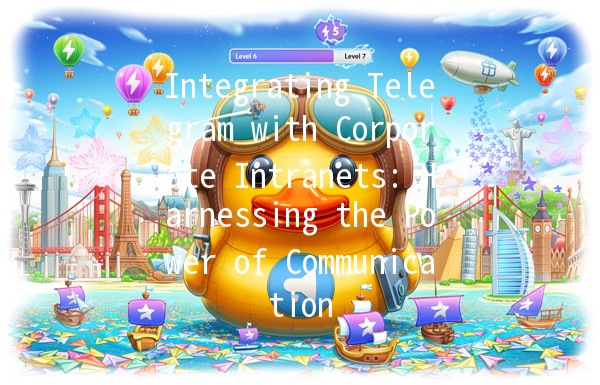Integrating Telegram with Corporate Intranets: Harnessing the Power of Communication 🚀💡

In today’s fastpaced digital world, effective communication is critical for businesses to thrive. With the rise of instant messaging applications, companies are seeking innovative ways to improve internal communication and operational efficiency. One such application is Telegram, a powerful messaging platform that offers robust functionalities beyond mere chatting. In this article, we will explore the integration of Telegram within corporate intranets, highlighting its benefits, potential use cases, and implementation strategies.
Understanding Telegram: A Brief Overview 📱
Telegram is a cloudbased messaging app that has gained immense popularity due to its speed, security, and extensive features. With over 500 million active users, it provides functionalities such as group chats, channels, bots, and file sharing. Unlike traditional communication tools, Telegram offers a unique blend of flexibility and accessibility, making it an attractive choice for businesses aiming to streamline communication and collaboration.

Key Features of Telegram
Telegram allows realtime instant messaging between users, complete with support for multimedia files, stickers, and emojis. Group chats can accommodate up to 200,000 members, making it a viable option for large organizations.
Channels are oneway communication tools where administrators can broadcast messages to a large audience. This feature is beneficial for disseminating important company announcements or updates.
Telegram bots can automate various tasks, from scheduling meetings to managing customer inquiries. Businesses can create custom bots tailored to their specific needs.
Telegram prioritizes user privacy and security. It offers endtoend encryption for secret chats, ensuring that sensitive business discussions remain confidential.
Users can share files up to 2GB in size, facilitating easy document sharing and collaboration among team members.
The Need for Integration with Corporate Intranets 🏢
An intranet serves as a private internal network within an organization. It provides a platform for employees to access information, communicate, and collaborate efficiently. While most intranets come with builtin communication tools, integrating Telegram can enhance these capabilities and provide additional benefits.
Advantages of Integrating Telegram with Intranets
Combining the functionalities of Telegram with corporate intranets allows employees to communicate seamlessly, whether they are in the office or working remotely.
Telegram’s interactive features, such as polls and quizzes, can foster employee engagement, making information dissemination and feedback collection more dynamic.
As a cloudbased platform, Telegram can be accessed from various devices, including smartphones, tablets, and desktops. This accessibility ensures that employees can stay connected regardless of their location.
The scalable nature of Telegram supports an increasing number of users without compromising performance, making it suitable for growing organizations.
Integrating Telegram into existing intranet systems can be more costeffective than subscribing to expensive enterprise communication tools, especially for small to mediumsized businesses.
Use Cases for Telegram in Corporate Intranets 💼
Integrating Telegram with corporate intranets can unlock numerous use cases, empowering teams to communicate more effectively.
Channels can be utilized to broadcast important announcements such as policy changes, upcoming events, or product launches. This ensures that employees receive timely information without overwhelming them with emails.
Telegram can serve as a hub for project teams, fostering realtime collaboration. Group chats can be dedicated to specific projects, allowing team members to share ideas, files, and updates.
By utilizing Telegram channels and bots, organizations can create a continuous learning environment. Training materials, resources, and quizzes can be shared via Telegram to facilitate ongoing learning and development.
Telegram’s polling feature enables organizations to gather feedback from employees quickly. This can be useful for assessing employee satisfaction or gauging opinions on new initiatives.
For businesses with customerfacing roles, Telegram can enhance communication with clients. Bots can handle common inquiries, and teams can discuss customer issues in realtime to expedite resolutions.
Implementing Telegram Integration: Key Considerations ⚙️
Adopting Telegram within corporate intranets requires careful planning to maximize its benefits. Here are essential considerations for successful integration:
Before integration, define the specific goals you wish to achieve. Whether it’s improving communication, increasing engagement, or streamlining processes, having clear objectives will guide your integration strategy.
Evaluate the technical aspects of integration, including API capabilities, compatibility with existing intranet systems, and security measures to protect sensitive company data.
Training employees on how to use Telegram effectively is critical. Provide resources and support to familiarize them with the platform’s features and functionalities.
Security should be paramount, especially when integrating a communication tool with sensitive company information. Define access controls, encryption protocols, and guidelines for using the platform.
Once integrated, continuously monitor usage, engagement levels, and feedback from employees. This data will provide insights for optimizing the platform and ensuring it meets evolving user needs.
Overcoming Challenges in Integration 🛠️
While the prospects of integrating Telegram with corporate intranets are promising, organizations may face challenges along the way. Here are common hurdles and how to navigate them:
Employees may be hesitant to adopt a new tool. To tackle this, emphasize the benefits of Telegram and involve employees in the integration process. Encourage feedback to foster a sense of ownership.
Integration may face technical challenges related to compatibility with existing systems. Collaborating with IT teams to conduct thorough assessments and testing can mitigate these risks.
Privacy and security are primary concerns when implementing a new communication tool. Regular audits of security measures and continuous training on best practices can help alleviate fears.
With enhanced communication comes the risk of information overload. Set clear guidelines on how to effectively use Telegram to prevent unnecessary distractions and ensure that important messages don’t get lost.
Measuring Success: Key Performance Indicators (KPIs) 📊
To assess the effectiveness of integrating Telegram within corporate intranets, businesses should define and monitor key performance indicators (KPIs):
Monitor how many employees are actively using Telegram within the intranet.
Track interactions, such as messages sent, group chat participation, and poll responses.
Analyze the speed and efficiency of communication compared to previous tools.
Gather qualitative feedback through surveys to understand employee satisfaction and areas for improvement.
Evaluate whether the integration has positively impacted project completion times and overall team productivity.
Future Trends in Workplace Communication 🌐
As technology evolves, so do workplace communication trends. The integration of applications like Telegram with corporate intranets aligns with several emerging trends:
The shift towards remote work necessitates seamless communication tools that can bridge the gap between team members, irrespective of location.
The growing use of AI chatbots within Telegram can further streamline customer interactions and internal processes.
Increasing attention to employee mental health means that communication tools must also facilitate social interactions and support networks among employees.
Businesses will continue to seek ways to integrate multiple platforms to create cohesive digital ecosystems, enhancing overall efficiency.
: Embracing the Future of Communication 🌟
Integrating Telegram with corporate intranets offers a myriad of benefits for organizations aiming to enhance communication, collaboration, and engagement. As businesses continue to adapt to the changing landscape of remote work and digital communication, tools like Telegram will play an essential role in fostering a connected and collaborative workplace.
By strategically implementing Telegram, setting clear goals, and prioritizing security, organizations can unlock its full potential and embrace the future of workplace communication. As we navigate this digital transformation, the ability to communicate effectively will remain a cornerstone of organizational success, driving innovation and growth in a competitive environment.
In this article, we explored the integration of Telegram within corporate intranets, discussing its features, advantages, use cases, implementation strategies, challenges, and future trends. As we move towards a more connected future, leveraging such tools can profoundly impact how organizations communicate and operate, ultimately leading to a more engaged and productive workforce.
Other News

如何在TelegramX中进行群组投票 🤖📊

Telegram安装时间优化 🚀📱

Telegram Mac版下載地址及其特色功能探索!
